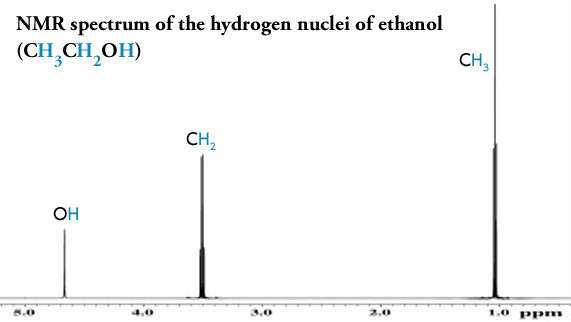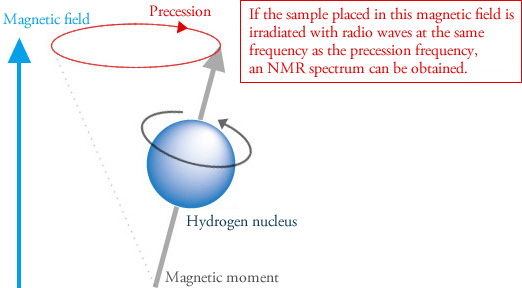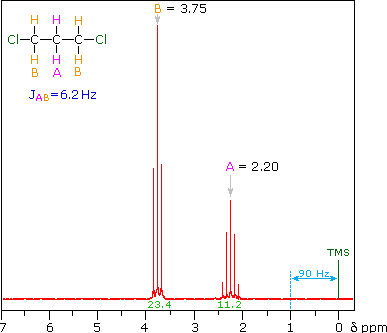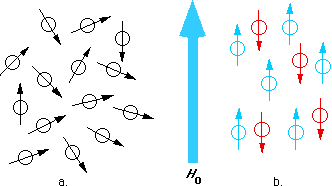1H NMR is used to determine the type and number of H atoms. The application of NMR spectroscopy to the study of proteins and nucleic acids has provided unique in- formation on the dynamics and chemical kinetics of these systems.
Nuclear Magnetic Resonance Spectroscopy.

. The SCSB NMR Laboratory is located in its own two-story. H0 is magnetic field which separates the energy into two. For the four common nuclei noted above the magnetic moments are.
It can be used to obtain in situ concentration measures for certain chemicals in complex samples such as the living brain. E2 12 γh 2Π H0. 1 H μ 27927 19 F μ 26273 31 P μ 11305 13 C μ 07022.
Wileyplus Nmr Spectroscopy And Nuclear Spin - An nmr spectrum is acquired by varying or sweeping the magnetic field over a small range while observing the rf signal from the sample. Nuclei with an odd mass or odd atomic number have nuclear spin in a similar fashion to the spin of electrons. The nuclei discussed in order are 1H 13C 15N 31P and 19 F.
Apart from the molecular structure NMR spectroscopy can determine phase changes conformational and configurational alterations solubility and diffusion potential Krishnan 2019. Nuclear Magnetic Resonance spectroscopy is a powerful and theoretically complex analytical tool. These moments are in nuclear magnetons which are 50507810-27 JT-1.
Edward Purcell and Felix Bloch developed the NMR technology in the late 1940s for which they earned a Nobel prize in physics. One is 12 which is anti-parallel to the magnetic field and the other is 12 which is parallel to the magnetic field. Nuclear Magnetic Resonance NMR Spectroscopy.
Nuclear Magnetic Resonance NMR Spectroscopy is a powerful analytical technique that can reveal structural information about many organic and inorganic molecules. Nuclear magnetic resonance NMR is a physical phenomenon in which nuclei in a strong constant magnetic field are perturbed by a weak oscillating magnetic field in the near field and respond by producing an electromagnetic signal with a frequency characteristic of the magnetic field at the nucleusThis process occurs near resonance when the oscillation frequency. The height of each step is proportional to the area under the resonance.
S0025 1D 1H nuclear magnetic resonance spectroscopy p0060 Simple one-dimensional 1H NMR spectroscopy is the most common approach in metabolomics studies and consists of an excitation pulse eg micro-seconds with an acquisition period seconds. Mass spectrometry MS is an analytical technique that is used to measure the mass-to-charge ratio of ionsThe results are presented as a mass spectrum a plot of intensity as a function of the mass-to-charge ratioMass spectrometry is used in many different fields and is applied to pure samples as well as complex mixtures. Nuclear Magnetic Resonance NMR Spectroscopy is a technique used for determining the structure of organic compounds.
It is important to remember that with NMR we are performing experiments on the nuclei of atoms not the electrons. It is used to determine the molecular structure at the atomic level of a sample. Nuclear magnetic resonance spectroscopy is a powerful analytical technique used to characterize organic molecules by identifying carbon-hydrogen frameworks within molecules.
This external energy applied to the molecule is absorbed and the perturbed nucleus is. Carbon Nuclear Magnetic Resonance 13 C-NMR SpectroscopyNuclear Magnetic Resonance NMR Spectroscopy is not limited to the study of protons. Nuclear magnetic resonance spectroscopy tutorial.
The biomedical applications of nuclear magnetic resonance NMR are twofold. The following diagram gives the approximate frequencies that correspond to the spin state energy separations for each of these nuclei in an external magnetic field of 235 T. Nuclear magnetic resonance NMR spectroscopy is a versatile tool that provides information on structures and dynamics of various biological and synthetic molecules at an atomic level.
Some nuclei possess a magnetic moment - such as a hydrogen nucleus 1H or a carbon nucleus 13C. In certain specific circumstances MRS also provides. Two common types of NMR spectroscopy are used to characterize organic structure.
A powerful technique useful for identifying the small to the very large When some atoms are placed in a strong magnetic field their nuclei behave. Magnetic resonance imaging MRI and magnetic resonance spectroscopy MRS. Nuclear magnetic resonance NMR spectroscopy is the study of molecules by recording the interaction of radiofrequency Rf electromagnetic.
The principle underlying this approach is that radio waves excite intramolecular magnetic fields around atomic nuclei resulting in. Nuclear magnetic resonance NMR spectroscopy is an advanced characterization technique. The applications of MRS as a research tool are extremely diverse encompassing studies on isolated cells body fluids and perfused organs at high magnetic field strengths in an experimental.
For scientists to be able to measure the exact structure of compounds to understand their properties is key. Hornak is Professor of Chemistry and Imaging Science at the Rochester Institute of Technology where he teaches courses in magnetic resonance imaging nuclear magnetic resonance spectroscopy analytical chemistry and physical chemistry. 2 6 integral d 36 d 12 The relative area under the resonances at d 36 and 12 is 13 The integral is superimposed over the spectrum as a stair-step line.
Nuclear magnetic resonance NMR is a spec- troscopic technique that detects the energy ab- sorbed by changes in the nuclear spin state. Nuclear magnetic resonance spectroscopy most commonly known as NMR spectroscopy or magnetic resonance spectroscopy is a spectroscopic technique to observe local magnetic fields around atomic nuclei. Nuclear magnetic resonance NMR spectroscopy explores the electronic environment of atoms.
On this page we will cover the basic theory behind the technique. The chemical environment of specific nuclei is deduced from. Nuclear Magnetic Resonance Spectroscopy Tutorial.
The area under an NMR resonance is proportional to the number of nuclei that give rise to that resonance. Nuclear Magnetic Resonance. Nuclear Magnetic Resonance Spectroscopy tutorial all along with the key concepts of Basic Principle of NMR The Source of NMR Spectra NMR spectrum Pattern of the Spectrum The NMR spectrometer Operational procedure Application of NMR.
Nuclear magnetic resonance NMR spectroscopy has a storied history. There are two major relaxation processes. Any element with a nuclear spin 13 C 17 O 19 F 31 P and many others will give rise to an NMR signalCarbon-13 has a nuclear spin I ½ and makes up 11 of all naturally occurring carbon a high enough abundance along with.
In NMR magnetic nuclei of specific isotopes are aligned by a strong external magnet and then perturbed by a radio wave. Magnetic resonance spectroscopy MRS is an analytical tool that detects radio frequency electromagnetic signals that are produced by the atomic nuclei within molecules.

Nmr Basic Knowledge Nuclear Magnetic Resonance Spectrometer Nmr Products Jeol

1 Nmr Spectroscopy Introduction To Proton Nuclear Magnetic Resonance Youtube

Nmr Basic Knowledge Nuclear Magnetic Resonance Spectrometer Nmr Products Jeol

Basic Introduction To Nmr Spectroscopy Youtube




0 comments
Post a Comment